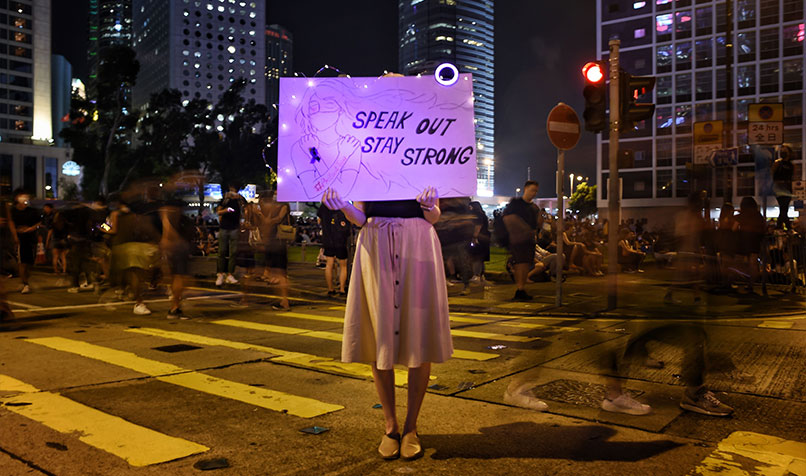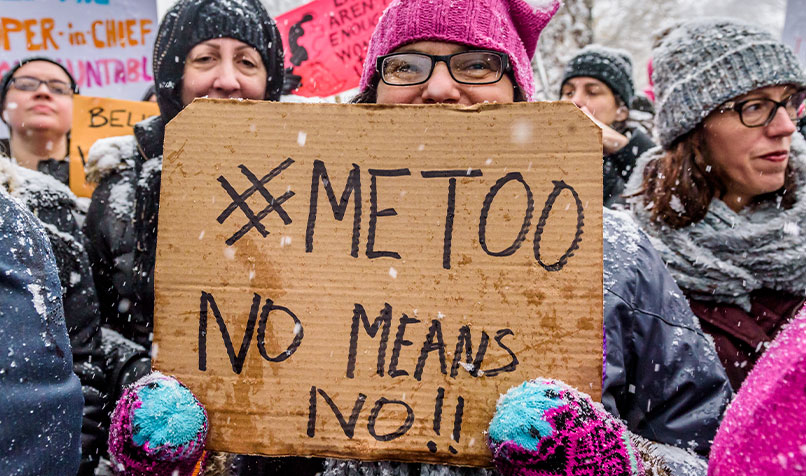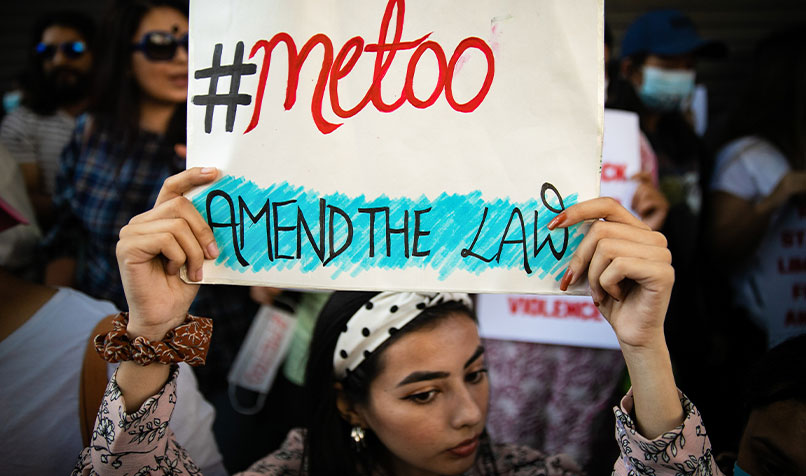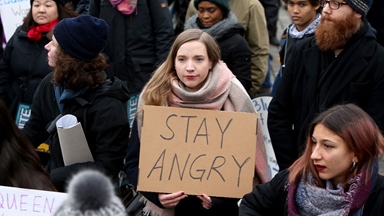Loading component...
At a glance
In 2017, a tweet sent by actress Alyssa Milano gave the burgeoning #MeToo movement the boost it needed to “go viral”. About half a million people responded to Milano’s tweet within 24 hours. The #MeToo movement would ultimately expose the scale and extent of sexual harassment and assault that women still experience at work.
Since then, the #MeToo movement has offered victims of sexual harassment a platform to speak out publicly.
However, six years on, the cost of speaking out – from intense media scrutiny and allegations of lying to threats of violence – is still too high for many.
In the workplace, sexual harassment and assault allegations are sometimes met with directives to sign non‑disclosure agreements, outright dismissal or a hostile environment that makes resigning the only feasible option.

HR Gurus director Emily Jaksch says she has seen progress in how workplaces are addressing the issue of sexual harassment.
“It used to be the norm that businesses would have a diversity policy that outlined acceptable and unacceptable behaviour, but now we are saying that is not enough,” Jaksch says.
A significant shift away from a complaint‑based system has also taken place, meaning that organisations must now proactively prevent their employees, workers, agents and the organisation itself from engaging in discriminatory conduct or harassment, she says.
“You need to make sure you are setting people up for success, as well as protecting the business,” Jaksch explains, “Because when things go wrong, it blows up very quickly. You’ve got to do more than the bare minimum.”
A positive duty to change

In 2018, Australia’s former Sex Discrimination Commissioner Kate Jenkins led a National Sexual Harassment Inquiry.
The inquiry found sexual harassment in Australian workplaces to be widespread and pervasive. About 39 per cent of women and 26 per cent of men had reported the experience of sexual harassment in the workplace in the previous five years.
Jenkins determined the existing legal and regulatory system was no longer fit for purpose. She recommended implementing a new model to improve the coordination, consistency and clarity between the anti‑discrimination, employment and work health and safety legislative schemes.
Five years later, speaking on the ABC’s 7.30 program, Jenkins pointed to a welcome shift from victims being responsible for reporting sexual harassment to a “positive duty”.
This positive duty puts the onus on employers to create safe workplaces.
“I think we are on the precipice of change. We need to focus on this in every workplace and in every industry. Australia has recognised sexual harassment at work is a problem, which is something we didn’t have five years ago,” Jenkins said on the program.
The positive duty is one of 55 recommendations Jenkins made in her 2020 Respect@Work Report. The Australian Government accepted some of its recommendations, which led to the implementation of the Anti‑Discrimination and Human Rights Legislation Amendment (Respect at Work) Act 2022.
As a result, since December 2022, Australian employers are required to take reasonable and proportionate measures to eliminate sexual harassment, sex-based discrimination and harassment, hostile workplace environments and victimisation in their organisation.

Annika Freyer, CEO of gender equality strategy firm Champions of Change Coalition, says this long-overdue law will ensure workplaces across Australia focus on prevention.
“The work undertaken by Kate Jenkins highlighted the prevalence of sexual harassment in workplaces across Australia. It elevated the need for and the approach to preventing sexual harassment to the government and the public domain,” Freyer says.
Gaslighting at work: what you need to know
A shift in attitude

Freyer also says that #MeToo has changed how people talk about sexual harassment and abuse.
“It is hard to overstate the significant change in attitude we have seen over the past few years in our workplaces, and, importantly, in the public understanding about sexual harassment and what constitutes harmful behaviour.
“The past few years have reinforced to all organisations that sexual harassment is no longer something that can be covered up,” Freyer says.
Freyer works with business leaders across a range of sectors. She says policies and practices needed to change, because they simply were not working.
“Old systems and policies that were designed to protect corporate reputations, especially in high-profile cases, were not preventing occurrences or responding appropriately to the needs of those affected.
“The biggest change for organisations addressing sexual harassment is the necessary shift from reputation management to harm prevention and responses that put the person affected first,” Freyer says.
In response, members of the Champions of Change Coalition have introduced multiple confidential avenues for employees to report sexual harassment, Freyer says.
They have also introduced education programs to support all employees to identify sexual harassment and know how to respond.
Workplace health and safety strategies are also available to help address sexual harassment as a physical and psychological safety issue.
“For some organisations, this has seen an increase in the numbers of incidents reported.
“Fifty per cent of our members are regularly providing internal updates on case numbers, de-identified cases and outcomes as part of their commitment to prevention,” Freyer says.
Why are some workplaces banning taboo topics?
Bystander action

When #MeToo brought the issue of sexual harassment into the broader public conversation, some workplaces had already started to look for proactive ways to stamp it out. This includes mandatory reporting policies.
Genevieve Collins, chief executive partner at law firm Lander & Rogers, says that developing a culture where sexual harassment is unacceptable is the result of a “holistic approach”.
“Having women in senior leadership roles has had a significant impact. Nearly half of our partners are female, four of our eight practice groups are led or co-led by women, and we have a female chair of our board.
“We have also introduced a range of policies and initiatives that set a workplace culture of respect for everyone,” says Collins.
The firm’s mandatory reporting policy of sexual harassment has been key, she says.
“We assessed that our culture was sufficiently mature, in that anybody who is affected by sexual harassment or witnesses it has a positive requirement to report it.”
Collins says this policy operates in conjunction with a policy on consensual workplace relationships. This requires mandatory, confidential disclosure of relationships that could lead to real or perceived conflicts of interest. It also addresses the complex nature of relationships that involve a power imbalance.
“Other policies that have played a significant role for us include our gender‑neutral parental policy and our fully hybrid working environment,” Collins says.
Jaksch says organisations that delay or dismiss addressing these issues as too hard or unimportant risk serious consequences.
“We sometimes find smaller businesses are less likely to realise how important this is, because they think they are a small family business where everyone is ‘friends’.
“That can be where the biggest problems occur, because you have that level of familiarity,” Jaksch says. “The Respect@Work Report has highlighted the issue. Directors and managers have a responsibility to be proactive to make sure the workplace is safe, and everybody knows that sexual harassment is not tolerated.”
For Collins, the positive duty is a welcome introduction. There are also many other ways for organisations of every size to take steps to create a culture where people feel safe, she says.
“When you place a positive duty on something, it focuses a mind. It raises awareness. It requires organisations to apply themselves, to think about how they are going to do it in the context of their own culture and organisation. I think that can only be a positive thing,” she says.

